Conflans-en-Jarnisy to Metz
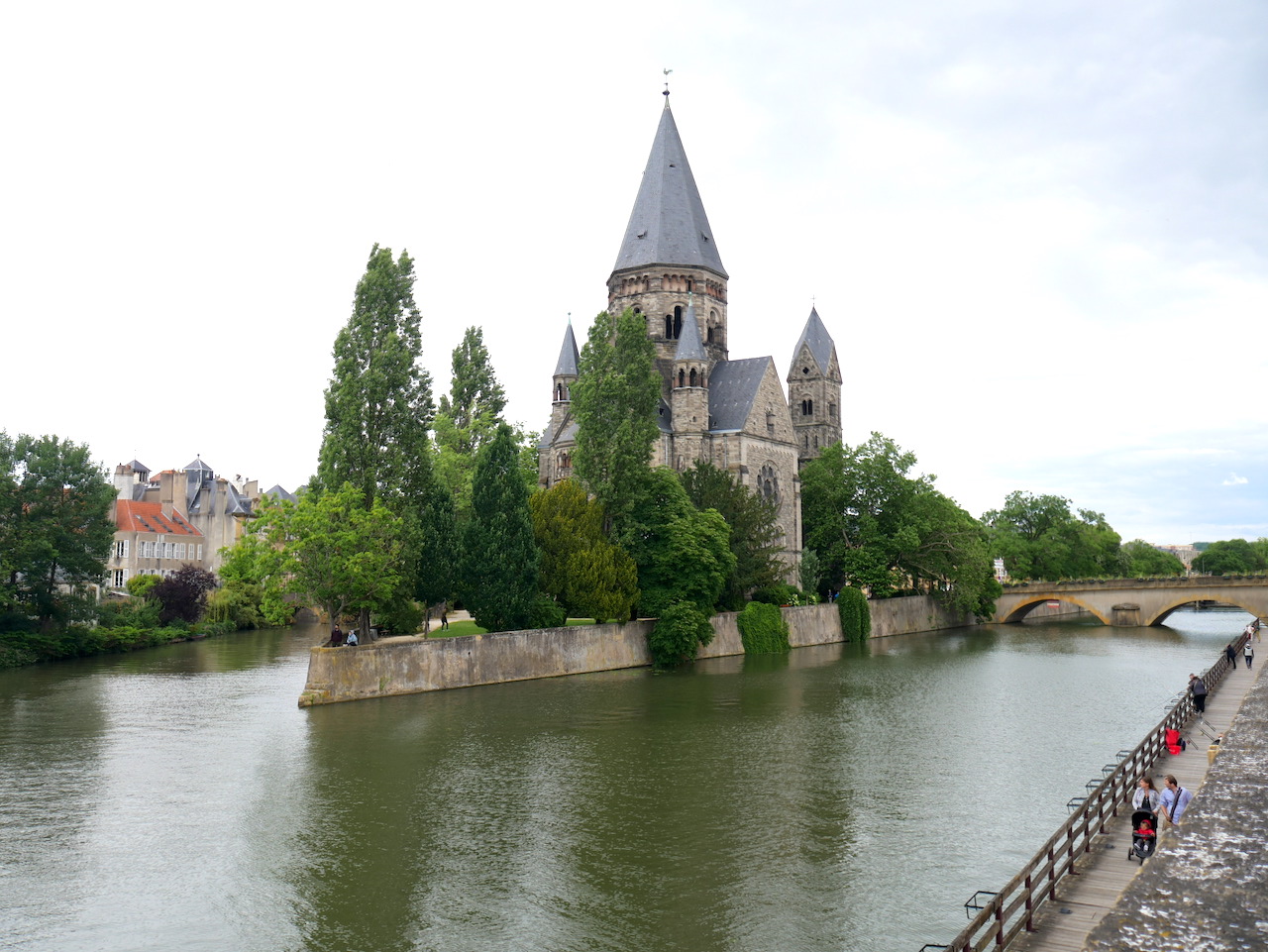
Grand Est
13. Conflans-en-Jarnisy to Metz
Difficult
7h30
29,3km
+399m
-406m
Step
Embed this item to access it offline
Starting from Jarny you will cross the last crops, then the forest and the wastelands will occupy the landscape as you descend towards Châtel Saint-Germain, an old fortified village. The Messinian agglomeration will accompany you as you discover Lessy and its church, then Scy-Chazelles and the Robert Schuman European Centre. The politician presented Saint Colomban as the father of modern Europe.
An important stage in the journey of Saint Colomban and his companions who stayed in Metz around 611. They were welcomed by King Théodebert, Colomban's faithful companion. Take a day's break to discover the important heritage of the former capital of Austrasia.
An important stage in the journey of Saint Colomban and his companions who stayed in Metz around 611. They were welcomed by King Théodebert, Colomban's faithful companion. Take a day's break to discover the important heritage of the former capital of Austrasia.
9 points of interest
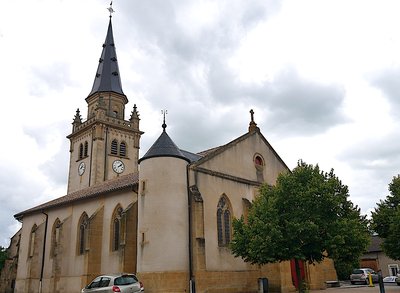
Église Saint-Maximin à Jarny - Image : Amis de saint Colomban TouristSaint-Maximin Church in Jarny
Church formed by a primary ogival style choir from the 13th century and a central nave belonging to the tertiary ogival period at the end of the 15th century, enlarged in 1765. The fortified bell tower is said to be one of the elements of the urban enclosure. Mural paintings, statuary. Restoration work in 2005 by the Municipality has restored all its character to this beautiful building. The restoration of 1962 led to the discovery of frescoes, that of 2005 a door of the dead, an old niche... Listed in the Supplementary Inventory of Historic Monuments since 1982. Since the renovation in 2005, guided tours have taken place every year on the occasion of the Heritage Days.
Monuments en hommage de 36 soldats prussiens du 9e bataillon de Chasseurs de Lauenburg. - Image : Amis de saint Colomban Historical1870-1871 war memorial plaque
After passing the hamlet of Chantereine you will come across a monument in honour of the 36 soldiers of the 9th Lauenburg Chasseurs Battalion (Prussian Army) killed there.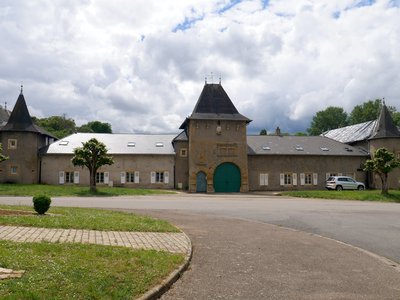
Château de Vernéville - Image : Amis de saint Colomban HistoricalThe castle of Vernéville
Vernéville depended on the old Val de Metz in the Middle Ages. Its lordship owned a fortified castle, fiefdom of the bishopric of Metz. The seigneury of Vernéville belonged to the de Roucel family in the 16th and 17th centuries. The seigniory was acquired at the beginning of the 18th century by members of parliament from Metz, Claude-François Jobal and François Huyn, lord of Montigny la Grange, whose son François-Louis-Paul Huyn, through his marriage in 1735 to Anne-Françoise de Jobal, reunited the entire seigniory in his hands. The Huyn de Vernéville family kept the property until the First World War. The castle was sold in co-ownership. Private property, the castle cannot be visited.
The Saint-Eloi church was built at the end of the 19th century.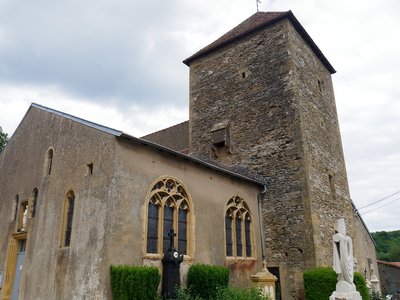
Église Saint-Gorgon à Lessy - Image : Amis de saint Colomban TouristSaint-Gorgon Church in Lessy
The 13th century bell tower imposes a first impression of massiveness. The choir is from the 15th century. The nave was rebuilt at the end of the 18th century. Observe the sundials on the bell tower.
The village, which dominates the Moselle valley, is very well exposed for the cultivation of vines, which has faded away in favour of real estate.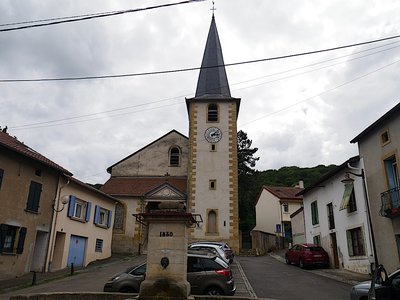
Église Saint-Germain à Châtel-Saint-Germain - Image : Amis de saint Colomban HistoricalSaint Germain Church in Châtel-Saint-Germain
Before arriving in Châtel-Saint-Germain you walked along a hill which was a strategic place to watch over the valley and the road from Metz to Paris. The site has been continuously occupied since the Neolithic period. Unfortunately very few remains are visible, except for the walls of the castle built in the 13th century by the bishop of Metz, with a beautiful view towards the Moselle valley.
The church of Saint-Germain in the centre of the city dates from the 18th century and replaces an older building.
Chapelle abritant la dépouille de Robert Schuman à Scy-Chazelles - Image : Amis de saint Colomban HistoricalRobert Schuman European Centre in Scy-Chazelles
The Via Columbani passes in front of the Robert Schuman European Centre in Scy-Chazelles.
It was in his home town that, during a weekend in April 1950, Robert Schuman, then Minister of Foreign Affairs, had the audacity to devise a "daring act" that would change the course of history. Together with other European statesmen, this great visionary created the conditions for lasting peace in Europe.
In July 1950, he organised a secret meeting with diplomats from different countries in Europe in Luxeuil-les-Bains. The official reason for this meeting on 21-22-23 July 1950 was to inaugurate the new statue of Saint Colomban, made by Claude Grange in 1935 and cast in 1947.
In his speech, in front of the abbey founded by Saint Colomban, Robert Schuman declared that Saint Colomban is the father of Europe through his writings and his message of unity under the banner of Christ.
Enter Robert Schuman's house and visit the museum to discover the work of this great visionary to prevent a new war in Europe.
Centre européen Robert Schuman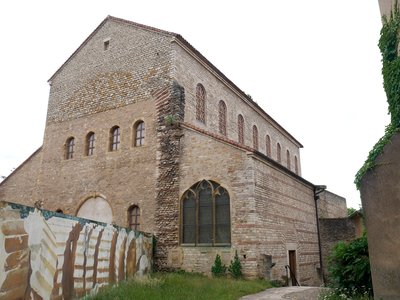
Façade orientale de l’église Saint-Pierre aux Nonnains à Metz - Image : Amis de saint Colomban HistoricalSaint-Pierre aux Nonnains Church in Metz
Originally it was part of a group of rooms connected by galleries reused from buildings of the Gallo-Roman period. The church of Saint-Pierre-aux-Nonnains was built between the end of the 4th century and the beginning of the 5th century probably in the civil basilica.
In 451, like many buildings in Messin, the complex was devastated by the Huns. It was left abandoned and then became a Benedictine abbey around 620.
In the 10th century, thanks to the donations of Emperor Otto, the church underwent important modifications, with the division of the nave into three vessels and the creation of a avant-nef (narthex). In one of the aisles we can still see a layout from the Ottonian period.
In the 15th century, the building was redesigned and a Gothic vault was created with a cross vault. The spiritual use of the building ceased in 1556 and it became a military storehouse. Today it is a place for cultural exhibitions.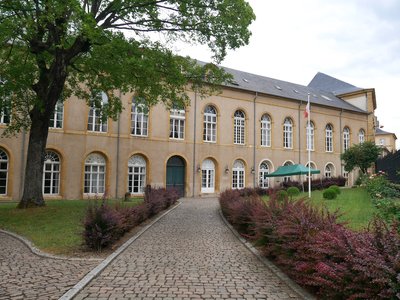
L'abbaye Saint-Arnould (actuel cercle des officiers) à Metz - Image : Amis de saint Colomban TouristSaint-Arnould Abbey in Metz
The first historical traces date back to the 6th century. In 717, it took the name of Saint-Arnoul, because of the relics of Arnoul de Metz, bishop of Metz in the 7th century, deposited in 641.
Charlemagne made this abbey the necropolis of part of his family: his wife Hildegarde, his sisters, his sons, the Emperor Louis the Pious and Bishop Drogon of Metz, Charlemagne's natural son and abbot of Luxeuil from 833 to 855, were buried there.
The abbey was destroyed by invasions in the 9th century and rebuilt in the 10th century. In the 11th century, relics of Gorgon, a 4th century Roman martyr, were transferred to the abbey.
The siege of Metz by Charles V in 1552 led to the destruction of the abbey. It was transferred, together with the imperial tombs, inside the ramparts to the Dominican Convent of Preachers, built in 1221, a convent which, with the exception of the church, was rebuilt in the 17th century. Today you can see these buildings, especially the cloister, the old refectory and the old sacristy, which are part of a military complex that cannot be visited.
More info at: Wikipedia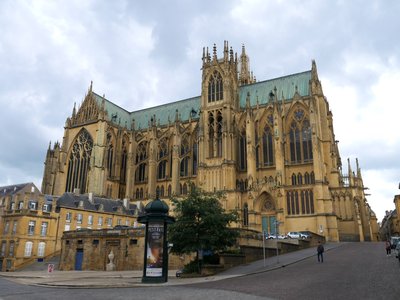
Cathédrale Saint-Étienne à Metz - Image : Amis de saint Colomban TouristSaint-Etienne Cathedral in Metz
Saint-Etienne's Cathedral is an imposing and majestic building, both by its dimensions, by its numerous monumental sculptures, by the importance of its glass roofs and by its golden lustre, due to the Jaumont stone.
It was built from 1220 under the impetus of the bishop of Metz Conrad de Scharfenberg. Its location is not due to chance since two religious buildings have successively preceded it. The first of them, an oratory, already existed at the time of the sacking of the city by the Huns in 451. Saint Colomban, during his stay in Metz with King Théodebert, probably prayed in this oratory near the royal palace.
The monument actually comprises two buildings: the cathedral and the collegiate church of Notre-Dame-la-Ronde, built around 1186 and redesigned to fit into the ensemble. The two towers of the cathedral mark the junction between these two churches. The Portal of the Virgin, the present entrance to the cathedral, was one of the portals of Notre-Dame-la-Ronde.
The imposing cathedral was not completed until three centuries later, in 1552, due to financial and political difficulties which led to the interruption of the construction work.
Metz Cathedral is an exceptional building and represents a "culmination of Gothic art", according to one of its many architects.
More information: Wikipedia
Description
From the church of Conflans-en-Jarnisy cross the crossroads, rue de Verdun, avenue Patton, avenue de la République, rue Gambetta, rue Pasteur turn left at the roundabout rue Pasteur, rue de Metz straight on at the roundabout, stay on the D 603 using the path parallel to the road to Doncourt-les-Conflans
- After the church in Doncourt-les-Conflans, turn left on rue Jean et Léon Michel, rue Charles Pêche, path in the fields, left at the crossroads, follow the main road.
- At the crossroads on the right, first road on the left, straight ahead, on the left at the crossroads before Anoux-la-Grange, straight ahead cross the hamlet D 13c then D 51, at Vernéville rue de Batilly, Grande-Rue, in front of the Monument aux Morts turn left rue de Chantrenne, cross D 11 straight ahead on asphalt road
- Châtel-Saint-Germain, route de Vernéville, turn right rue de Verdun, left at the junction rue Jeanne d'Arc, turn left rue de Lessy, rue Châtel-Saint-Germain, after the church straight on rue de la Butte, turn right rue du Château direction Scy-Chazelles.
- Turn left at the crossroads with D 103g rue de Scy, route de Lessy, at the first houses turn right on chemin de terre in front of the tourist information sign, allée Saint-Rémi, turn right on rue Jeanne d'Arc straight on chemin du Corchu.
- Second street on the left rue Robert Schuman, rue de l'Abbé Roget, on the left at the crossroads rue Alfred Pichon direction Longeville-les-Metz, rue du Général Hirschauer at the roundabout straight on rue Robert Schuman
- At the junction with the RN3, turn right a few meters to cross the RN3, turn left to follow the road without going up to the bridge, stay on avenue du Général De Gaulle, use the stairs at the foot of the Verdun bridge, cross the Moselle, boulevard Saint-Symphorien, pass under the highway.
- Take the Saint-Symphorien bridge after the first canal on the left down pedestrian path towards allée Saint-Symphorien, allée du Bras-Mort, cross the lock, quai des Régates follow the Moselle, at the bridge take stairs to continue quai Paul Vautrin on the right bank of the Moselle, second street on the right rue du Pont des Roches, on the right rue d'Estrées you will arrive at the Saint-Etienne cathedral.
- Departure : Saint-Martin Church, 4 rue de Verdun, 54 800 Conflans-en-Jarnisy
- Arrival : Saint-Etienne Cathedral, Place d'Armes, 57,000 Metz
- Towns crossed : Grand Est
Altimetric profile
Report a problem or an error
If you have found an error on this page or if you have noticed any problems during your hike, please report them to us here:








